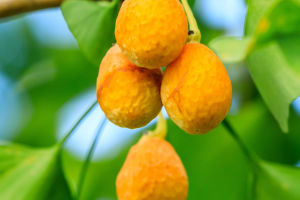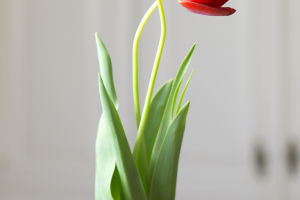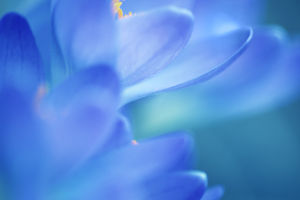
Living Fossil

Ginkgo is a tree belonging to the Ginkgoaceae family and Ginkgo genus. It is a deciduous tree that can grow up to 40 meters tall with a trunk diameter reaching up to 4 meters.
The bark of young trees is shallowly furrowed, while mature trees have gray-brown bark deeply furrowed and rough. The tree crown is conical in young and middle-aged trees, becoming broadly ovate in older trees.
Its fan-shaped leaves, with long petioles, are light green, hairless, with numerous parallel veins that fork, measuring about 5-8 centimeters wide at the tip. Leaves on short shoots often have wavy margins, while those on long shoots are often bifurcated, with a wide wedge-shaped base.
The male and female reproductive structures, known as ovules and pollen cones, are borne on separate trees in clusters at the tips of short shoots. Male pollen cones hang in catkin-like structures. The seeds have long stalks, are pendulous, and can be elliptical, long ovoid, ovoid, or nearly spherical.
Related
 Ginkgo trees offer medicinal nuts, but careful consumption is crucial due to their toxicity.
Ginkgo trees offer medicinal nuts, but careful consumption is crucial due to their toxicity.
 Tulips are Nature's love and rebirth in vibrant blooms.
Tulips are Nature's love and rebirth in vibrant blooms.
 Lavender is a versatile herb, offers calming properties, aids skincare, repels insects, and intertwines with love in folklore.
Lavender is a versatile herb, offers calming properties, aids skincare, repels insects, and intertwines with love in folklore.
 Crocus cartwrightianus is nature’s elixir.
Crocus cartwrightianus is nature’s elixir.
 The profound significance of roses in bridal bouquets embodies love, tradition, and symbolic communication.
The profound significance of roses in bridal bouquets embodies love, tradition, and symbolic communication.
 Acquire the skills to preserve tulip flower arrangements!
Acquire the skills to preserve tulip flower arrangements!
From an aesthetic perspective, Ginkgo leaves resemble open fans, a unique trait rarely found in the plant kingdom. The soft curves of fan-shaped leaves, especially like those of Ginkgo, align well with traditional Eastern aesthetics. It's no wonder that decorative items and ornaments often draw inspiration from Ginkgo leaves.
The striking beauty of Ginkgo leaves is not merely superficial; remarkably, the shape of these leaves has remained almost unchanged when compared to Ginkgo leaf fossils dating back millions of years. Evolutionary biology terms this phenomenon as "morphological stasis," one of the reasons Ginkgo is hailed as a "living fossil."
Considering the vast period involved, during which the Earth underwent significant transformations, the steadfast preservation of these small leaves is truly remarkable.
Ginkgo trees thrive in natural forests with well-drained, acidic (pH 5-5.5) loamy soil at altitudes ranging from 500 to 1000 meters. They often grow alongside other trees like cypress, fir, and blueberry trees. Ginkgo is prized for its fast-growing and valuable wood, with light yellow sapwood and light yellow-brown heartwood. It possesses a fine structure and is lightweight, elastic, easy to work with, and glossy.
With a density ranging from 0.45 to 0.48, it resists cracking and warping, making it excellent for construction, furniture, interior decoration, carving, and drawing boards. The seeds are edible (though excessive consumption can lead to poisoning) and have medicinal uses. Ginkgo leaves can be used in medicines and as insecticides, as well as fertilizer.
The fleshy outer seed coat contains toxic compounds like ginkgolic acid, ginkgol, and ginkgolides. The bark contains tannins. Ginkgo trees have an elegant form, with tender green leaves in spring and summer turning yellow in autumn, making them aesthetically pleasing and suitable for gardens and streets.
Ginkgo trees have a strong demand for nutrients, adapting well to fertile soil and tolerating fertilizers. Proper fertilization is crucial for their maintenance. Generally, during the leaf budding stage in spring (March to April), fertilizers promoting leaf growth should be applied. Around February, fast-acting chemical and organic fertilizers, such as animal or human manure, can be applied at a rate of 2 to 5 kilograms per tree, adjusted based on tree size.
In summer, as Ginkgo enters fruiting stages, fertilizers aiding fruit growth, like urea (0.5 kilograms per tree around early July), should be used. Adequate watering should follow fertilization during dry spells. In autumn, when Ginkgo sheds its leaves, nutrients supporting overall tree health should be applied. September to October is the period for seed maturation and harvest, followed by a surge in root growth.
Therefore, fertilization during this time compensates for nutrient loss due to fruiting, ensuring a fruitful year. Typically, applying farm manure at a rate of 3 kilograms per kilogram of produced fruit is recommended.

Regular pruning of Ginkgo trees aims to remove dead, thin, and diseased branches, maintaining a heart-shaped or rounded canopy for healthy crown growth.
In winter, to protect against cold, wrapping tree trunks with grass ropes or whitewashing them is common. Whitewashing usually involves using a lime sulfur solution with added salt, preferably done in autumn to reduce sun absorption, minimize day-night temperature fluctuations, and prevent freezing.
Maintenance of Ginkgo gardens involves regular removal of weeds, and shrubs, periodic inspection of drainage and irrigation systems, and maintenance of sloped planting areas. Garden management offices are typically located near the main transportation routes within the garden for effective oversight.